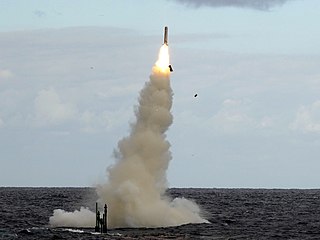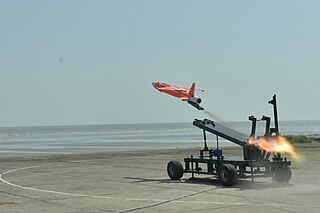
A cruise missile is an unmanned self-propelled guided missile that sustains flight through aerodynamic lift for most of its flight path. Cruise missiles are designed to deliver a large payload over long distances with high precision. Modern cruise missiles are capable of traveling at high subsonic, supersonic, or hypersonic speeds, are self-navigating, and are able to fly on a non-ballistic, extremely low-altitude trajectory.

A submarine-launched cruise missile (SLCM) is a cruise missile that is launched from a submarine. Current versions are typically standoff weapons known as land-attack cruise missiles (LACMs), which are used to attack predetermined land targets with conventional or nuclear payloads. Anti-ship cruise missiles (ASCMs) are also used, and some submarine-launched cruise missiles have variants for both functions.

The BrahMos is a medium-range ramjet supersonic cruise missile that can be launched from submarines, ships, fighter aircraft or TEL. It is a joint venture between the Indian Defence Research and Development Organisation (DRDO) and the Russian Federation's NPO Mashinostroyeniya, who together have formed BrahMos Aerospace. The missile is based on P-800 Oniks. The name BrahMos is a portmanteau formed from the names of two rivers, the Brahmaputra of India and the Moskva of Russia.

Gas Turbine Research Establishment (GTRE) is a laboratory of the Defence Research and Development Organisation (DRDO). Located in Bengaluru, its primary function is research and development of aero gas-turbines for military aircraft. As a spin-off effect, GTRE has been developing marine gas-turbines also.

The Indian Ballistic Missile Defence Programme is an initiative to develop and deploy a multi-layered ballistic missile defence system to protect India from ballistic missile attacks. It was launched in 2000 after the Kargil War by the Atal Bihari Vajpayee government. Testing was carried out and continuing as of 2006, and the system was expected to be operational within four years according to the head of the country's missiles development programme, Vijay Kumar Saraswat.

Agni-I is a short-range ballistic missile that was developed by DRDO of India in the Integrated Guided Missile Development Program. It is a single-stage missile that was developed after the Kargil War to fill the gap between the 250 km (160-mile) range of the Prithvi-II missile and the 2,500 km (1,600-mile) range of the Agni-II. It was first launched from a road mobile launcher at Integrated Test Range (ITR), Wheeler Island, on 25 January 2002. Less than 75 launchers are deployed.

The HSTDV is an unmanned scramjet demonstration aircraft for hypersonic flight. It is being developed as a carrier vehicle for hypersonic and long-range cruise missiles, and will have multiple civilian applications including the launching of small satellites at low cost. The HSTDV program is being run by the Defence Research and Development Organisation (DRDO).
The Indian Air Force has been undergoing a modernization program to replace and upgrade outdated equipment since the late 1990s to meet modern standards. For that reason, it has started procuring and developing aircraft, weapons, associated technologies, and infrastructures. Some of these programs date back to the late 1980s. The primary focus of current modernization and upgrades is to replace aircraft purchased from the Soviet Union that currently form the backbone of the air force.
India has studied, produced and used various strategic and tactical missile systems since its independence. Decades long projects have realised development of all types of missile systems including ballistic, cruise, anti-ship, air-defence, air-to-air and anti-missile systems. India is one of seven countries in the world with intercontinental ballistic missiles (ICBMs) and one of four countries with anti-ballistic missile systems. Since 2016, India has been a member of Missile Technology Control Regime (MTCR).

The DRDO Abhyas is a high-speed expendable aerial target being built by the Aeronautical Development Establishment (ADE) of the Defence Research and Development Organisation (DRDO) for the Indian Armed Forces.
BrahMos-II or BrahMos-2 or BrahMos Mark II is a hypersonic scramjet-propelled missile currently under joint development by India's Defence Research and Development Organisation and Russia's NPO Mashinostroyenia, which have together formed BrahMos Aerospace Private Limited. The BrahMos-II is expected to have a range of 1,500 kilometres and a speed of Mach 8. During the cruise stage of flight, the missile will be propelled by a scramjet airbreathing jet engine. Other details, including production cost and physical dimensions of the missile, are yet to be published.

The Rudram is a series of supersonic and hypersonic air-to-surface ground attack and anti-radiation missiles in development by the Defence Research and Development Organisation of India. It can be launched from a range of altitudes with large standoff distance for destroying enemy surveillance radars, communication stations and bunkers.

Pralay is a canisterised surface-to-surface, short-range ballistic missile (SRBM) for battlefield use developed by the Defence Research and Development Organisation (DRDO) of India. The missile is an amalgamation of technologies developed for exoatmospheric interceptor missile Prithvi Defence Vehicle (PDV) from the Indian Ballistic Missile Defence Programme, and the Prahaar tactical missile. The project to develop Pralay was sanctioned in March 2015 with a budget of ₹332.88 crore.

Akash - New generation abbreviated as Akash-NG is a mid-ranged mobile surface-to-air missile defense system developed by the Defence Research and Development Organisation (DRDO) and produced by Bharat Dynamics Limited (BDL) and Bharat Electronics (BEL).

NASM–SR or Naval Anti-Ship Missile–Short Range is a helicopter launched anti-ship missile being developed by the Defence Research and Development Organisation for the Indian Navy. It is the first indigenous air launched anti-ship cruise missile developed for the Indian Navy. The missile is manufactured by Adani Defence & Aerospace.
This article consists of projects of the Defence Research and Development Organisation (DRDO).

The Long Range – Anti Ship Missile (LRAShM) is a hypersonic missiles being developed by the Defence Research and Development Organisation (DRDO) for the Indian Armed Forces.



















